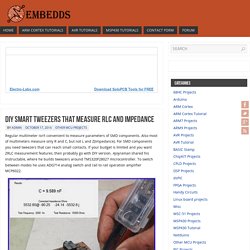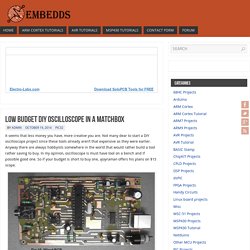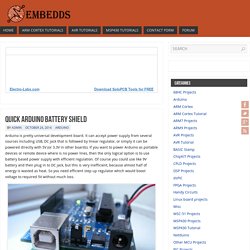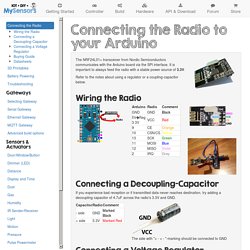

A Sound-Reactive RGB LED Bookshelf. What can a guy that has a 5000-volume library complete with a 1930’s era pipe organ (see around 2:20 in the video below) do to enhance his reading space?

I’m not sure what my answer would be, but for Craig Landrum, the answer was to build a sound-reactive shelving unit. Not only does it react to the sound’s volume, it uses a Fast Fourier Transform to separate out the frequencies observed. This means that one shelf can react to a high-pitched note, while another would react to a lower pitched note. The shelves are controlled by a really professional-looking panel made out of powder coated aluminum, purchased from a company called Front Panel Express. The status dispaly on the top shows the different frequencies coming into the shelves, and other selectors control whether the shelf is on, as well as different options.
Surplus Center. DIY smart tweezers that measure RLC and impedance. Regular multimeter isn’t convenient to measure parameters of SMD components.

Low budget DIY oscilloscope in a matchbox. It seems that less money you have, more creative you are.

Not many dear to start a DIY oscilloscope project since these tools already aren’t that expensive as they were earlier. Anyway there are always hobbyists somewhere in the world that would rather build a tool rather saving to buy. In my opinion, oscilloscope is must have tool on a bench and if possible good one. So if your budget is short to buy one, ajoyraman offers his plans on $15 scope. Low budget DIY oscilloscope in a matchbox. Arduino based WebRadio player. Vassilis Serasidis always creates great embedded projects.

This time he introduced Arduino based WebRadio player. This particular one uses Arduino Pro Mini which interfaces VS1053 MP3 -AAC – WMA audio codec chip module. For internet connectivity he used pretty standard ENC28J60 Ethernet module. Visual feedback is on 84×48 Nokia 5110 LCD. Since internet is full of radio stations that broadcast music, you can use a bit of your bandwidth and listen to radio. Quick Arduino battery shield.
Arduino is pretty universal development board.

It can accept power supply from several sources including USB, DC jack that is followed by linear regulator, or simply it can be powered directly with 5V (or 3.3V in other boards). If you want to power Arduino as portable devices or remote device where is no power lines, then the only logical option is to use battery based power supply with efficient regulation. Of course you could use like 9V battery and then plug in to DC jack, but this is very inefficient, because almost half of energy is wasted as heat.
So you need efficient step up regulator which would boost voltage to required 5V without much loss. Attiny85 based dual lead acid battery charger. Superbender has a constant problem with his camper bus batteries.

Normally camper is left over the winter and so batteries dies without proper care. In camper there are two batteries – main starting and auxiliary. So he decided to build a dual battery charger to keep them alive over the winter season. He already had a 15V 5A power supply which seemed to be just right. Since batteries will be connected to charger over all winter time, charging current doesn’t play a significant role.
Remote Arduino based temperature logger with ESP8266 module. Temperature loggers can be useful and vital in many places.

For instance they can be implemented on greenhouses, freezers and other sensitive environments where temperature changes can cause trouble. Temperature logging can help finding weak spots in the system and help prevent failures in future. Some time ago temperature loggers relied on internal storage devices, where temperature data along time stamps were saved locally that later had to be loaded in to computer to visualize data.
Today when internet of things services are here, logging can be done online without need of storing data locally. You can see logged data instantly, set alerts and even remotely control hardware. The MQTT Connection. MQTT stands for MQ Telemetry Transport.

It is a publish/subscribe, extremely simple and lightweight messaging protocol, designed for constrained devices and low-bandwidth, high-latency or unreliable networks. The design principles are to minimise network bandwidth and device resource requirements whilst also attempting to ensure reliability and some degree of assurance of delivery. These principles also turn out to make the protocol ideal of the emerging “machine-to-machine” (M2M) or “Internet of Things” world of connected devices, and for mobile applications where bandwidth and battery power are at a premium.
Connecting the Radio to your Arduino. The NRF24L01+ transceiver from Nordic Semiconductors communicates with the Arduino board via the SPI interface.

It is important to always feed the radio with a stable power source of 3.3V. DIY Custom Guitar. How to Build a Computer from Scratch: The Complete Guide. Home automation system uses REST API. A $250 3-D Printer With Breakthrough Software. The Mod-T is a $250 3-D printer from New Matter.

As ambitious as the low-cost hardware is, the startup's digital platform is arguably as groundbreaking as the low-cost printer itself. New Matter A clever bit of engineering is what lets New Matter sell the Mod-T at such a low price. By using just two rods to move the build plate, the number of components for the mechanism is far lower than other printers. Soundhawk's earpiece lets you pick exactly what you want to hear. Would you wear a hearing aid if you didn't really need one? Say you could hear perfectly — or at least very well — and there was something that could dramatically and selectively improve your hearing in noisy places, like a crowded bar or restaurant. Would you do it then? That's the premise of Soundhawk, a $299 "smart listening system" designed by a group of former hardware and software engineers from Palm, Apple, and Amazon.
For the past two years, the company's been working on an in-ear headset that will let you pick what you want to hear using a smartphone app that can draw out certain sounds. They also think they've designed something that you'll want to have in your ear at all times, and that won't get you strange looks. The small headset is called the Scoop. "This was inspired by ophthalmologists, and watching them test people for eyewear," says Mike Kisch, Soundhawk's president and CEO. DIY vacuum tube amplifier. The PS/2 Mouse/Keyboard Protocol. Author: Adam Chapweske Last Updated: 05/09/03 Legal Information: All information within this article is provided "as is" and without any express or implied warranties, including, without limitation, the implied warranties of merchantibility and fitness for a particular purpose.
This article is protected under copyright law. This document may be copied only if the source, author, date, and legal information is included. Abstract: The PS/2 Keyboard Interface. Author: Adam Chapweske Last Updated: 04/01/03 Legal Information: All information within this article is provided "as is" and without any express or implied warranties, including, without limitation, the implied warranties of merchantibility and fitness for a particular purpose.
This article is protected under copyright law. This document may be copied only if the source, author, date, and legal information is included.